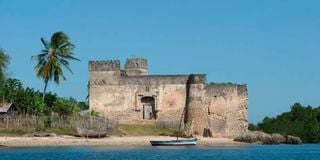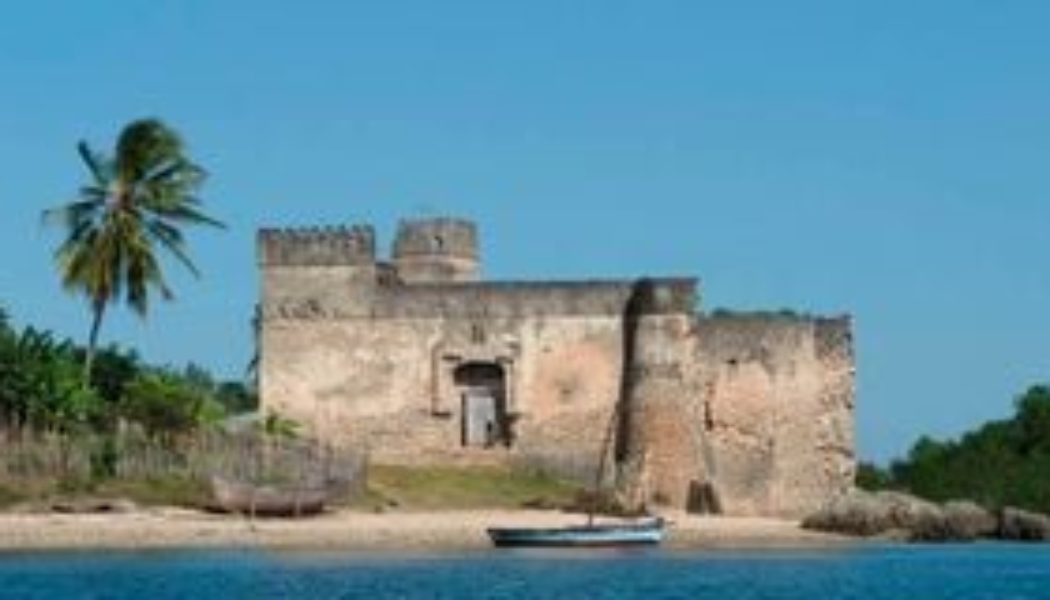My quest to visit all the ancient Swahili trading cities now leaves world heritage site Kilwa Kisiwani, which lies on the Kilwa archipelago on the south-eastern Coast of Tanzania and Sofala located in present day Mozambique.
Unguja is the latest of a string of bucket-list ticks that include Gede, Lamu, Malindi, Mombasa and Pate Island. Suffice to say, Unguja and Lamu have adeptly woven modernity and their past to present humanity with an authentic cultural experience of a historic living town.
Unguja, familiarly called Zanzibar Island, is the main island in the Tanzanian archipelago of Zanzibar in the Indian Ocean. What is lost to many is that there are at least 50 plus smaller islands including Pemba that make up Zanzibar that united with mainland Tanganyika to form Tanzania in 1964.
I watch, sitting in a window-yes in a literal window of Serena’s Masahani bar, the rocking turquoise waters of the Indian ocean crash into a sea wall.
In the foreground, a retrospective mzee in a cap flexes an accordion while his mates follow with an oud (fetless lute), qanoun (larp harp) and percussion. A stand-out lady in a hijab pleasurably draws a bow across the strings of a violin as they melodiously generate the distinct and authentic taarab sound that announces that you are in the heart of a Swahili city.
The ultimate historic stage of this heritage is Unguja’s Stone Town, a World Heritage Site of narrow winding streets marked by barazas, limestone white buildings with ornately carved timer doors and elaborate balconies with intricate fretwork, that reflect its particular culture conmprising homogenised disparate elements of the cultures of Africa, Arabia, China, India and Europe over more than a millennium.

Kilwa Kisiwani Ruins, Tanzania.
Photo credit: Pool
Together with the narrow, winding street pattern, large mansions facing the seafront and open spaces, these buildings form an exceptional urban settlement.
Around Stone Town are neatly stacked wattle homesteads whose palm thatched roofs have given way to rusty iron sheets. Blasting from the past is a large ceremonial palace built by Sultan Barghash aptly named House of Wonders.
Old Fort that shares architecture with Mombasa’s Fort Jesus towers next to it. You will also not miss the Old Dispensary screaming in green. Also distinctive is Christ Church Anglican Cathedral built on the site of the last slave market.
The residence of the slave trader Tippu Tip; the Malindi Bamnara Mosque; the Jamat Khan built for the Ismaili sect; the Royal Cemetery; the Hamamni and other Persian baths make for the island’s intoxicating aged skyline.
I reckon Moi International Airport was the trendiest airport in the 70’s when it was built. Today, however, Abeid Amani Karume formerly known as Zanzibar is the jewel of this coast. I should know having arrived in Unguja from Mombasa on the newly launched route by budget Jambojet.
As if to spite her equally famous sister, the eight ferries costing $40 that shuttle passengers to and from Dar es Salaam also humble our Likoni contraptions.
There are no online taxi hailing apps, but I recommend hiring a scooter given the good condition of the roads and the fairly sober drivers. You will need it if you will be savouring the dreamier beaches like the one in Nungwi village located in the north of the island where I spent most of my time.
“With Mombasa, and Lamu, is Zanzibar worth the trouble?” one person inquired after my return from this foremost city Swahili that Africans also refer to as Unguja
My answer is a firm yes. The culture is distinctly similar, but the experience sure is different.
First is the evident history the islands boasts. You must know that Zanzibar was a possession of the Sultans of Oman from the 17th Century who also laid claim to a mile long, 10 mile wide strip of the Kenya mainland coast from Kipini on the mouth of the Tana River to the Umba River in the South.
Traces of that influence can be seen to date via the buildings such as Sultan’s Palace, as well as influences in religion and culture. The slave market of Stone Town has been inactive for decades, but memorials provide a stark reminder of the horrific acts that once took place here. Add this to the influence the western world brought in after recognising the importance of Zanzibar as a trading post early 19th Century.
The United States established a Consulate there in 1837, Britain in 1841 and France, Portugal, Italy, Belgium and Germany followed thereafter.
Did you know that the lead singer of Queen was born in Zanzibar? That’s right – Freddy Mercury was born right in Stone Town in the 1940s. Back then Zanzibar was a British Protectorate and Mercury’s family had moved to Zanzibar for his father’s job.
Yes, you can even see right where Mercury lived in Shangani place in the heart of Stone Town, in a neatly preserved museum with images depicting the different stages in his life.
A walk around stone town is pleasant enough. While Old Town Mombasa is slowly deteriorating, Stone Town is actively exploiting her cultural heritage and seems to have gained a new lease of life, courtesy of the intentional restoration of her iconic buildings and improved infrastructure.
This ultimate tourist destination is highlighted by the famous Forodhani market, that comes alive every evening. Irresistible street food, freshly harvested from the ocean as heartbeat youth showcase acrobatic flips on the beach or scream your name in a dramatic fashion, before jumping off a pier, keeps animates Stone Town and allows vendors to earn a dignified living.
I can’t help but picture Mombasa’s Mama Ngina Drive picking a leaf or two from this distinct night street food operation. For an elevated experience, Capetown Fish Market Restaurant, Park Hyatt, Tembo and Zanzibar Serena hotels boast best sea view locations, whose second rows are marked by innumerable souvenir stores.
Speaking of souvenirs, while the generational Tanzanite gemstone touted to be at thousand times rarer than diamonds is mined in Merelani mine, some 50 kilometres from Arusha, its beauty is showcased in the innumerable jewellery stores and museums that litter stone town.
Spare a few hours to learn the complexities involved with its mining, the skills involved in cutting and polishing, and the stories and myths surrounding the rock. I would say that apart from Tiffany and Company, who in a vigorous sales promotion, named the stone “tanzanite”, Unguja has done splendid work marketing this deep blue gemstone the western world ‘discovered’ in 1967.
Its traditional custodians, the Maasai, have called the most precious and intensely coloured violet-blue gems Ayanda. According to Peter Bancroft’s classic book, Gem and Crystal Treasures (1984), when first mined, fine stones could be purchased in Tanzania, Kenya, and the United States for as little as $20 a carat.
By 1984, clean gems wholesaled at better than $1000 a carat, an indication of increasing interest in a gem already in short supply. In contrast, an even rarer Tsavorite (Green Garnet) is mined in Taita Taveta in a blanket of secrecy that only benefits the few who control its trade.
The east is also well covered as Sultan Seyyid Hamoud-bin-Mohammed-bin-Said, in the mid-19th Century encouraged Indian traders to establish themselves in Zanzibar and to a large extent the development of the economy of the island was due to their efforts.
Copra, ivory and spices-not to mention slaves-were exported while imports included cloth, metal-ware and beads. It was throughout the 19th Century the chief emporium for trade on the African East Coast.
That legacy lives on and being a producer of spices such as cloves, nutmeg, cinnamon, and black pepper, Zanzibar gained the name “Spice Islands”. The spice market in Unguja is a perfect opportunity to indulge your sense of smell as well as shop for authentic spices.
Not all Zanzibar beaches are created equal. Mnemba island is largely regarded as one of the best dive and snorkel spots in Zanzibar. Mnemba Island covered with casuarinas entertains not more than 20 guests (10 rooms) at a time. Chumbe Island, on the other hand, forms a part of a protected coral reserve.
Chapwani Island also on the west offers you the sight of varied fascinating marine creatures that are left stranded in the pools left by the receding tide.
With ocean all around, $35 will buy you a sunset dhow cruise while $65 will afford you a unique dry immersion of the marine life in a semi-submarine excursion. One of the sought after destination will be $15 Prison Island located 5.6km northwest of Stone Town.
The island was formerly owned by an Arab who used it for the confinement of refractory slaves, but no prisoners were ever properly housed there; instead, the island became a quarantine station for the yellow fever epidemic.
The island is a 30-minute boat ride from the town of Matemwe on Unguja’s East coast. When you spend time here, you will be amazed to see how humans can live without leaving a footprint on the environment..
As you walk along the seashore, you could spot egrets, white herons, coconut crabs and hermit crabs.
The island also has a small population of dik diks. Go on snorkeling expeditions around the private islands and revel in the splendor of the ocean on your travels in Zanzibar. Nungwi beach where I stayed boasts white sand that will burn your eyes. I paid 10$ to access the Instagram popular Nungwi Mnarani Aquarium that is a sea turtle conservation project after walking half-a-kilometre from my accommodation in Essque Zalu that I highly recommend for couples seeking.
Oh, the southern ‘kusi’ wind driven rainy months of March to May are the cheapest to visit Unguja. You and I know that those storms, though fierce, are typically short, offering dramatic skies and spectacular sunsets. Note that until 2025, Ramadan, the Islamic month of fasting, also begins in March.
Visitors may find some restaurants and shops closed during the day, but the evenings come alive after the fast is broken. Now that your appetite is whet, go on to get your yellow fever shot in preparation of your trip.
The actual jail was built in 1893, hence the name “PRISON ISLAND”, and is still standing. Peacocks and giant tortoises have taken over this island the locals call Changuu Island. Make it early for a snorkel swim before the tide makes it hard for the dhows to dock.









